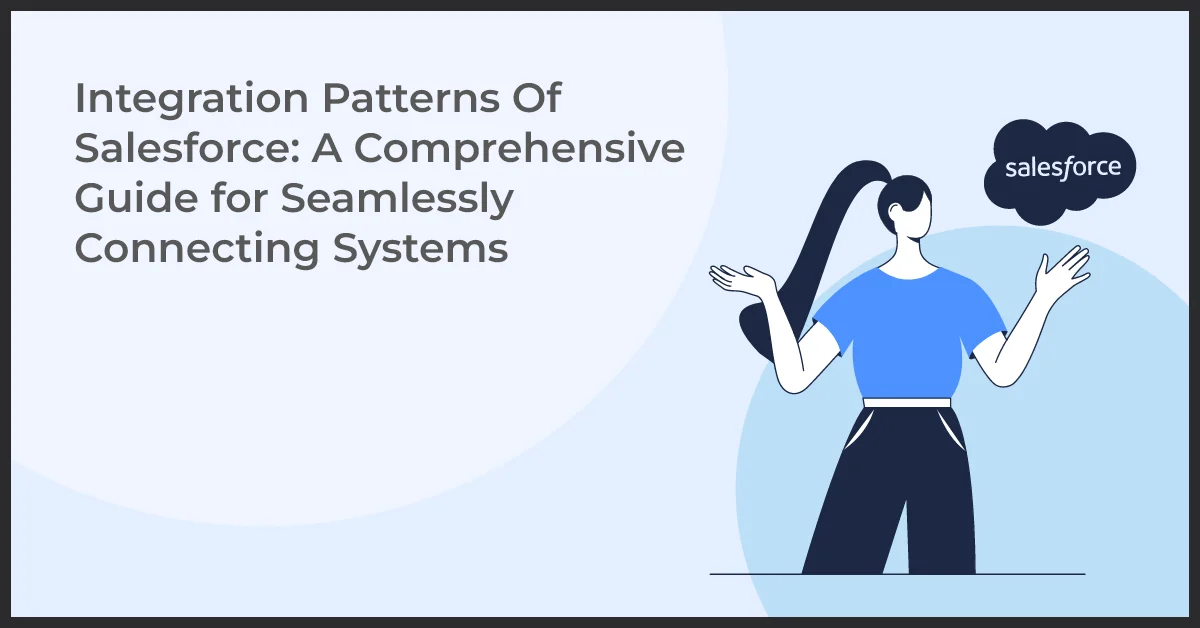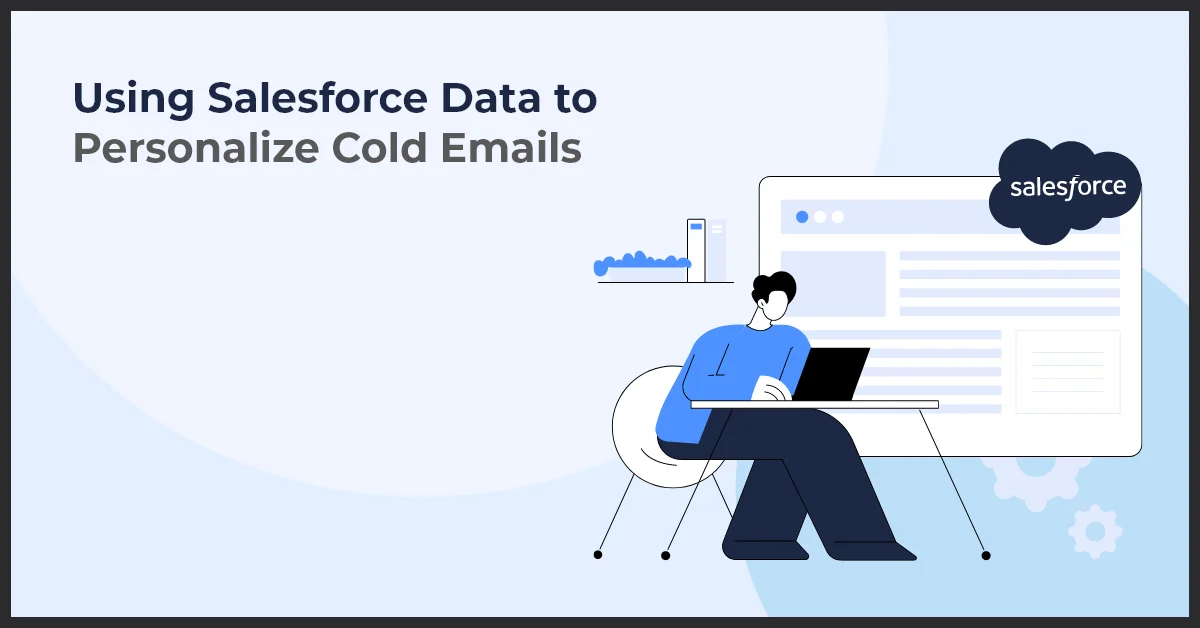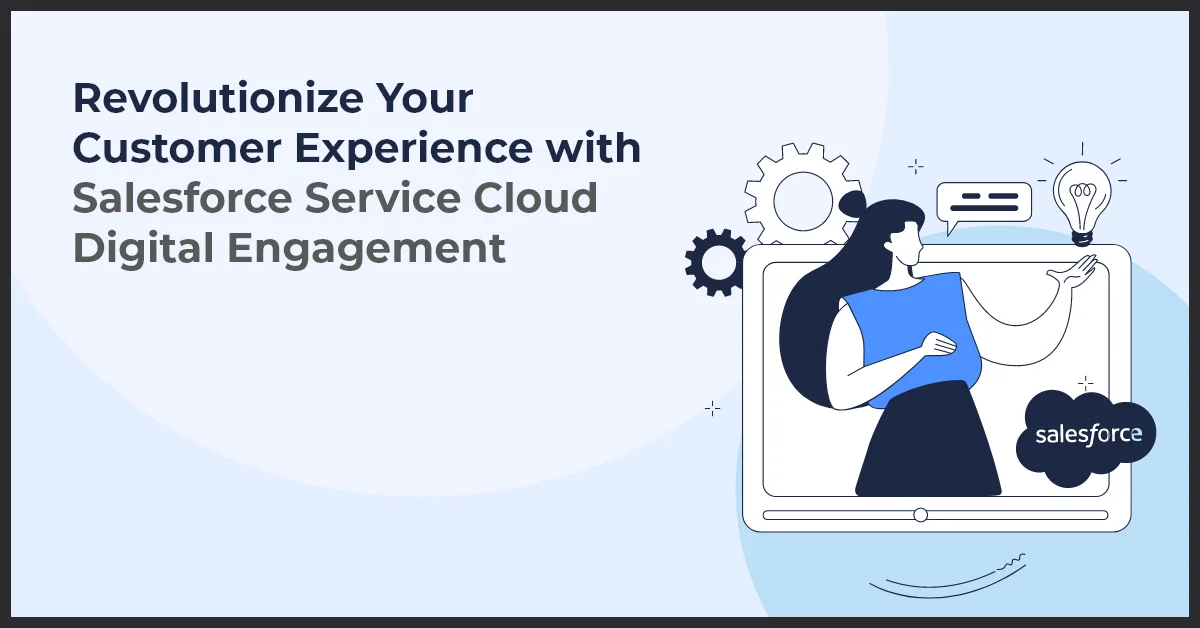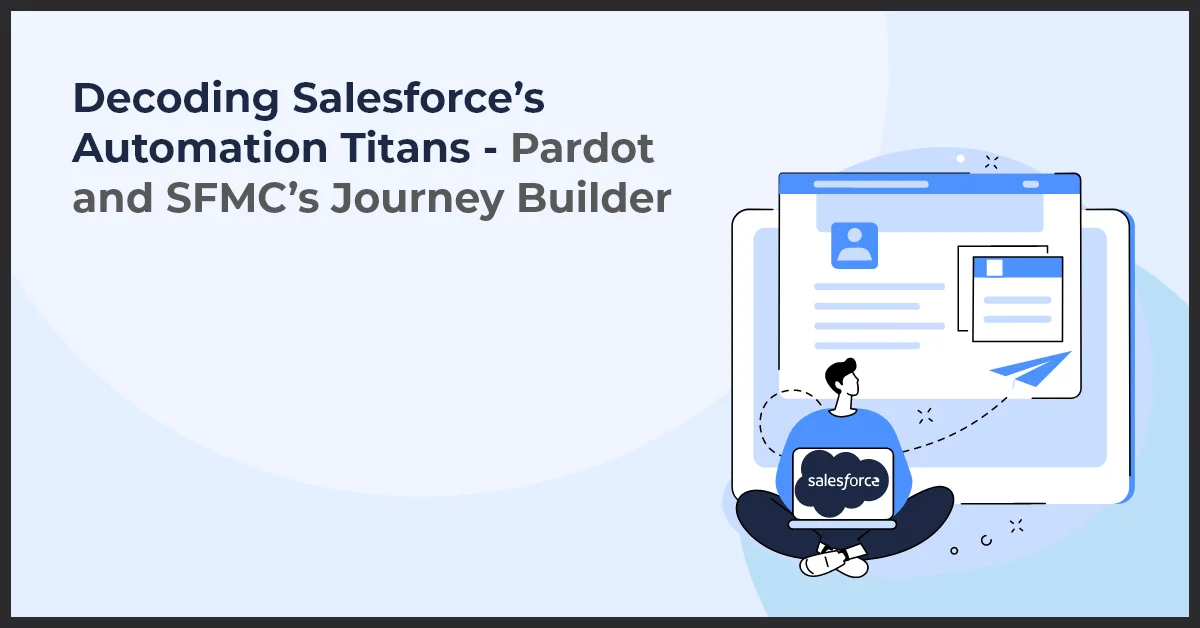Integration Patterns Of Salesforce: A Comprehensive Guide for Seamlessly Connecting Systems

Published on: November 14, 2023
Updated on: July 11, 2024
896 Views
- Salesforce
11 min read
Are you looking to optimize your business processes and streamline data across various systems? Look no further than integration patterns. In this comprehensive guide, we will explore what Salesforce patterns are, why they are essential for integrating Salesforce with other systems, and provide a detailed content plan to help you navigate through these patterns effectively.
Salesforce patterns for integration refer to the established methods and techniques for seamlessly connecting Salesforce with other applications, databases, or services. These patterns provide standardized frameworks that enable efficient data exchange, real-time updates, and synchronized operations between Salesforce and external systems.
Integrating Salesforce with other systems plays a crucial role in enhancing operational efficiency, reducing manual effort, and enabling a holistic view of your data. By integrating Salesforce with your preferred applications, such as marketing automation platforms, customer support systems, or ERP software, you can have a unified system that empowers your team to make data-driven decisions, improve customer experiences, and boost overall productivity.
In this content, we will delve into the different patterns, including point-to-point integrations, event-driven architectures, batch data synchronization, and API-led approaches. You will gain insights into the advantages and limitations of each pattern and understand which one suits your specific integration requirements.
Furthermore, we will discuss best practices, tips, and considerations for implementing integration patterns successfully. You will learn about the various integration tools, connectors, and APIs available in the Salesforce ecosystem, helping you choose the right solution for seamless integration.
Whether you are a Salesforce administrator, developer, or business leader, this guide will equip you with practical knowledge and actionable steps to effectively integrate Salesforce with other systems, drive business growth, and unlock the full potential of your Salesforce investment.
Understanding Salesforce
What is Salesforce?
Salesforce is a leading cloud-based customer relationship management (CRM) platform that helps organizations effectively manage their sales, marketing, and customer service operations.
Overview of Salesforce platform and its capabilities
Salesforce offers a comprehensive suite of tools and features that enable businesses to streamline their operations and enhance their customer interactions. It provides functionalities such as lead management, opportunity tracking, contact management, and sales forecasting.
Additionally, Salesforce offers a robust automation framework, advanced analytics, and customizable dashboards to help businesses make data-driven decisions and optimize their sales processes.
Benefits of integrating Salesforce with other systems
- Enhanced Data Visibility: By integrating Salesforce with other systems such as marketing automation, email marketing, and customer support platforms, businesses gain a holistic view of their customer data. This enables them to deliver personalized experiences and engage with customers across various touchpoints.
- Improved Efficiency: Salesforce eliminates manual data entry and reduces duplication of efforts by automating data synchronization between systems. This saves time and resources, allowing sales teams to focus on closing deals and providing exceptional customer service.
- Better Decision-making: Integrating Salesforce with business intelligence tools and data warehouses enables businesses to analyze sales data in real-time. This empowers decision-makers to identify trends, pinpoint potential bottlenecks, and make data-driven strategic decisions.
- Seamless Workflows: Integration facilitates the seamless flow of data between Salesforce and other systems, ensuring that the right information reaches the right people at the right time. This promotes collaboration, streamlines processes, and enhances overall productivity.
- Flexibility and Scalability: Salesforce allows businesses to adapt and grow by connecting with third-party applications and services. This flexibility enables them to extend the functionality of Salesforce to meet their evolving needs while maintaining a centralized repository of customer data.
Understanding the integration of Salesforce is crucial for businesses looking to leverage the full potential of their CRM platform. By integrating Salesforce with other systems, organizations can unlock greater efficiency, gain comprehensive insights, and deliver exceptional customer experiences.
The Basics of Integration
Integration Concepts
Integration is the process of combining different systems, applications, or platforms to work together seamlessly. It allows for the transfer and synchronization of data between these systems, enabling businesses to streamline their processes and improve efficiency.
Data plays a crucial role in integration. It is the information that needs to be shared or synced between the integrated systems. This data can include customer information, sales data, inventory details, and much more. Without proper management and understanding of data, integration efforts may fail to deliver the desired results.
API (Application Programming Interface) integrations are one of the most common and efficient ways to achieve seamless data exchange between systems. APIs enable different software applications to communicate with each other, allowing them to send and receive data in a standardized and structured manner.
The HTTP (Hypertext Transfer Protocol) protocol is often used in integration to facilitate the transfer of data between systems. It provides a set of rules and procedures for data communication, ensuring that information is transmitted and received correctly.
Integration Patterns of Salesforce
Integration patterns are established methodologies or frameworks for integrating Salesforce with other systems. They provide a structured approach to handle different integration needs and challenges.
There are various integration patterns available, each designed to address specific requirements. Some common patterns include point-to-point integration, batch data synchronization, real-time data synchronization, and event-driven integration.
Each integration pattern comes with its own set of limitations and advantages. Understanding these factors is crucial for selecting the right pattern for your specific integration requirements. It involves considering factors such as data volume, complexity, real-time needs, scalability, and extensibility.
Best practices suggest evaluating the integration patterns based on factors like system architecture, data security, performance, maintainability, and cost-effectiveness. Choosing the most suitable pattern ensures the success and reliability of your integration.
Common Integration Patterns
When integrating Salesforce with external systems, there are several common patterns that can be utilized to ensure efficient data transfer and synchronization. These patterns can be broadly categorized into real-time integration, batch processing integration, and point-to-point integration.
Real-time Integration Patterns
Real-time integration patterns focus on enabling live data transfers between Salesforce and external systems. This ensures that the data in both systems is always up-to-date and synchronized.
- Real-time Integration: This pattern involves establishing a direct connection between Salesforce and the external system, allowing real-time data replication and synchronization.
- Event-driven Integration: Utilizing events, such as changes in data or specific triggers, to initiate real-time data synchronization between Salesforce and the external system.
- Message Queues: Message queuing systems play a crucial role in real-time integration by buffering and managing the transfer of data between Salesforce and the external system.
Batch Processing Integration Patterns
Batch processing integration patterns involve transferring and processing data in batches rather than real-time. This approach is useful for scenarios where near real-time synchronization is not necessary.
- Batch Processing: This pattern involves transferring and processing data in predefined batches, either in scheduled intervals or based on specific triggers.
- ETL (Extract, Transform, Load): The ETL process involves extracting data from Salesforce, transforming it to meet the requirements of the external system, and then loading it into the target system.
- Synchronization: Achieving data consistency by synchronizing the data between Salesforce and the external system at regular intervals or based on specific triggers.
Point-to-Point Integration Patterns
Point-to-point integration patterns focus on establishing direct communication between Salesforce and the external system without the need for intermediate components or systems.
- Point-to-Point Integration: This pattern involves direct system-to-system communication, allowing data transfer between Salesforce and the external system without any intermediaries.
- Middleware: Middleware solutions can be utilized to facilitate point-to-point integration by providing additional features such as data transformation, routing, and monitoring.
- Web Services: Web services serve as a communication mechanism for point-to-point integration, allowing systems to exchange information using standard protocols and formats.
Integration with External Systems
When it comes to integration, it's not just about connecting with other Salesforce systems or applications within the cloud. Many businesses also need their Salesforce platform to seamlessly interact with external systems. This allows for a unified and efficient data flow, enabling a holistic view of the overall business operations.
There are several ways to integrate Salesforce with external systems, and each approach has its own advantages and considerations. Let's explore two popular integration patterns:
A. Salesforce and Cloud Integration
1. Cloud Integration: Integrating Salesforce with cloud-based systems
Salesforce provides robust capabilities to integrate with various cloud-based systems such as ERP (Enterprise Resource Planning), Marketing Automation, or Customer Support platforms. This integration allows businesses to streamline their operations by synchronizing data between Salesforce and other cloud applications.
2. Benefits and challenges of Salesforce cloud integration
Integrating Salesforce with cloud-based systems offers several benefits, including enhanced data accuracy, improved productivity, and better decision-making based on unified data insights. However, it does come with challenges such as data mapping complexities, security considerations, and the need for effective change management.
B. Salesforce and RESTful APIs
1. Overview of RESTful APIs and their relevance in Salesforce
RESTful APIs have gained popularity as a standard approach for web services. Salesforce supports RESTful APIs, making it easier to integrate with a wide range of external systems. These APIs enable seamless communication and data exchange between Salesforce and external systems through HTTP protocols.
2. Best practices for implementing RESTful APIs with Salesforce
Implementing RESTful APIs with Salesforce requires careful planning and adherence to best practices. This includes designing efficient API endpoints, securing API access through authentication and authorization mechanisms, and implementing error handling and data protection mechanisms to ensure data integrity and confidentiality.
C. Salesforce and SOAP
1. Understanding SOAP and its usage with Salesforce
SOAP (Simple Object Access Protocol) is another integration option for connecting Salesforce with SOAP-based systems. SOAP enables communication between Salesforce and external systems by exchanging XML-based messages over various protocols such as HTTP.
2. Integrating Salesforce with SOAP-based systems
To integrate Salesforce with SOAP-based systems, developers need to define the necessary SOAP operations and data structures in Salesforce, set up secure connectivity, and handle SOAP-specific error handling and data transformation requirements.
Data Integration and Migration
Data integration and migration are crucial aspects of Salesforce. In order to ensure a seamless flow of data between systems, organizations need to employ effective strategies and follow best practices.
Data Integration Strategies
1. Data Integration: Ensuring smooth data flow between systems
Smooth data integration is essential for organizations looking to synchronize data between Salesforce and external systems. By establishing a reliable data integration strategy, businesses can streamline their processes and achieve a single source of truth for their data.
2. Data Transformation: Converting and mapping data for seamless integration
When integrating systems, data may need to be transformed and mapped to match the format and structure of the target system, Salesforce. This involves converting data from one format to another and ensuring that data elements are correctly mapped to their corresponding fields in Salesforce. By carrying out effective data transformation, organizations can ensure a seamless data integration process.
Data Migration to Salesforce
1. Overview of data migration considerations and challenges
When migrating data to Salesforce, organizations need to consider various factors and overcome challenges. These may include data cleansing, ensuring data integrity, mapping legacy data to Salesforce objects, and handling data dependencies. By carefully analyzing these considerations and challenges, businesses can ensure a successful data migration process.
2. Best practices for successful data migration to Salesforce
To ensure a successful data migration to Salesforce, organizations should follow best practices. This includes mapping and reorganizing data according to Salesforce's data model, deduplicating and standardizing data, validating data accuracy, and conducting thorough testing and data validation before the actual migration. By adhering to these best practices, businesses can minimize data migration risks and ensure a smooth transition to Salesforce.
Conclusion
In conclusion, this content has provided a comprehensive overview of integration and the various integration patterns involved. We began by understanding the basics of integration and then explored common integration patterns. We also discussed integration with external systems and the challenges involved in data integration and migration.
Throughout this content, we have emphasized the importance of choosing the right integration pattern for Salesforce. The choice of integration pattern can significantly impact the success of your Salesforce implementation. It determines the efficiency, scalability, and flexibility of your integration solution.
As businesses become increasingly dependent on Salesforce for their daily operations, it is crucial to prioritize Salesforce to optimize processes and streamline workflows. By integrating Salesforce with other systems and data sources, businesses can improve cross-functional collaboration, enhance customer experiences, and gain valuable insights from a 360-degree view of their data.
In conclusion, Salesforce integration plays a vital role in ensuring the success of your organization. It enables businesses to unlock the full potential of Salesforce and drive growth through seamless data synchronization and automation. By carefully selecting the right integration pattern and implementing a well-designed integration strategy, businesses can harness the power of Salesforce to achieve their goals and stay ahead in today's competitive market.
Frequently Asked Questions
Integration patterns are vital in Salesforce for connecting disparate systems, ensuring data consistency, enhancing automation, and providing a unified view of information, improving efficiency and decision-making processes.
Key integration patterns include point-to-point, middleware, event-driven, batch, and API-based integrations, each offering unique benefits for connecting Salesforce with other systems seamlessly.
Organizations can leverage Salesforce’s robust integration capabilities and tools like Salesforce Connect and Data Loader to synchronize data between Salesforce and external platforms, ensuring data consistency and accessibility across systems.
Integration patterns in Salesforce streamline business processes by automating data flow, improving data accuracy, enabling real-time insights, and enhancing collaboration, ultimately driving productivity, efficiency, and business growth.
Salesforce offers real-time integration capabilities through APIs, Platform Events, and Change Data Capture, enabling seamless communication and data exchange between Salesforce and external systems for instant updates and real-time decision-making.



